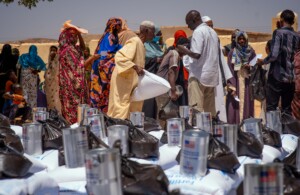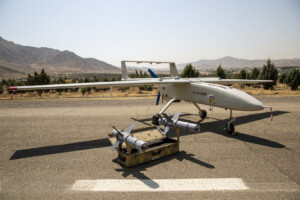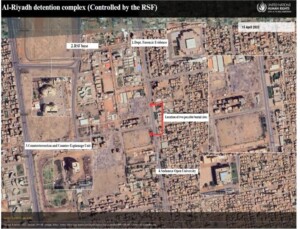Sudan’s poverty rates potentially even higher than reported
Sudan’s poverty and food insecurity rates are projected to increase further until September. Numbers are said to be significantly higher than those estimated by the country’s authorities and the United Nations (UN).
 Malnutrition in Sudan: a little boy being tested for malnutrition with Mid Upper Arm Circumference test (MUAC) and receiving special fortified food from WFP at a WFP-supported clinic in El Obeid, North Kordofan, in May 2022 (WFP)
Malnutrition in Sudan: a little boy being tested for malnutrition with Mid Upper Arm Circumference test (MUAC) and receiving special fortified food from WFP at a WFP-supported clinic in El Obeid, North Kordofan, in May 2022 (WFP)
Sudan’s poverty and food insecurity rates are projected to increase further until September. Numbers are said to be significantly higher than those estimated by the country’s authorities and the United Nations (UN).
The Integrated Food Security Phase Classification (IPC) explained that “with significant increases in food and other commodity prices, a reduced harvest, and continued conflict, acute food insecurity in Sudan continues to worsen rapidly”.
“Latest acute food insecurity data indicates that around 9.6 million people across Sudan were highly food insecure and classified in Crisis (IPC Phase 3 or above) from April to May 2022. This includes 2.3 million people in IPC Phase 4 (Emergency) and 7.3 million in IPC Phase 3 (Crisis)”, a report released last week indicated.
The percentage of the population in crisis or emergency phase levels of food insecurity has moved from 13% in October 2021 to February 2022, to 20 per cent in April and May 2022, and is expected to reach 24 per cent between June and September 2022, “driven by a plummeting economy, poor harvests, and conflict”.
The states that are projected to have the highest proportion of people in need of urgent action are West Darfur (42%), North Darfur (36%), and Central Darfur (35%), the IPC data shows. Especially displaced people, returnees, those stranded in conflict areas, and refugees are at risk.
Last month, the United Nations World Food Programme (WFP) has warned that "a record 15 million people in Sudan – one-third of the population – are currently facing acute food insecurity," and that this number may climb to 40 per cent by September.
The October 25 military coup has significantly worsened the situation for many people as Sudan was denied more than $4.4bn in foreign aid, its trade balance deficit nearly tripled, and humanitarian organisations struggle to continue their activities in the country.
Dozens of people reportedly died of hunger in the Foro Baranga camp for the displaced in West Darfur in the past three months, as national and international aid organisations have faced ongoing challenges accessing and distributing food and goods in the camp since the coup.
Real figures even higher
Like other countries that are subject to military regimes and suffer from low rates of transparency, there is a large gap between the officially announced figures on poverty indicators and the actual reality in Sudan.
While UN reports indicated in April that 46.5 per cent of the country's population lives below the poverty line, some organisations and outlets, including Noon Post, question the validity of these statistics as UN statistics are derived from official national data issued by the Sudanese government.
Before the October 25 military coup, during the civilian-led government headed by PM Abdallah Hamdok in 2020, for example, the Sudanese Social Security Commission announced that 77 per cent of all Sudanese lived below the poverty line, pointing out that their per capita income did not exceed $1.25 per day.
Other experts estimated that the actual rate exceeds the 80 per cent barrier, much higher than the reported 46.5 per cent.
All the figures announced for poverty rates in Sudan are also based on the local poverty index, set at 1.9 US dollars per day per capita, but if it is calculated on the global poverty index of $3.5 per day, more than 95 per cent of the Sudanese people would fall under the poverty line, Noon Post explained.
This situation raises alarm bells about the future of a country that possesses enormous natural wealth but where current wages meet about 10 per cent of the living requirements.
'They used to tell people to buy lentils instead of meat to save money, now people won't even be able to buy lentils'
Low wages
Sudan has been witnessing a large number of strikes and protests recently, following the federal authorities’ failure to implement the promised 2022 salary structure for civil servants, which increases wages amidst Sudan’s rising inflation. Despite almost being halfway through the year, many workers are still paid their old salaries instead of the increased 2022 wage.
Asma Osman (45), an Arabic language teacher in Omdurman, told Noon Post that during the last four years she was forced to work a second job in a library in order to meet her needs.
After more than 10 years of service, her salary does not exceed SDG 15,000 (which equalled $33.5 in April) per month. This amount is far from enough to meet the daily needs of her family as her husband works in the same profession and receives a salary similar to hers.
Sources told Radio Dabanga earlier this year that schools, especially many private education institutes that popped up during the regime of Al Bashir (1989-2019), have difficulties to appoint or keep teachers as they earn more doing odd trades or working as rickshaw drivers.
A social media user said that whilst talking to her family about the impending famine, one quickly realises that the severity of the issue is not well-known. Her grandmother (86) said that "they used to tell people to buy lentils instead of meat to save money, now people won't even be able to buy lentils".











 and then
and then